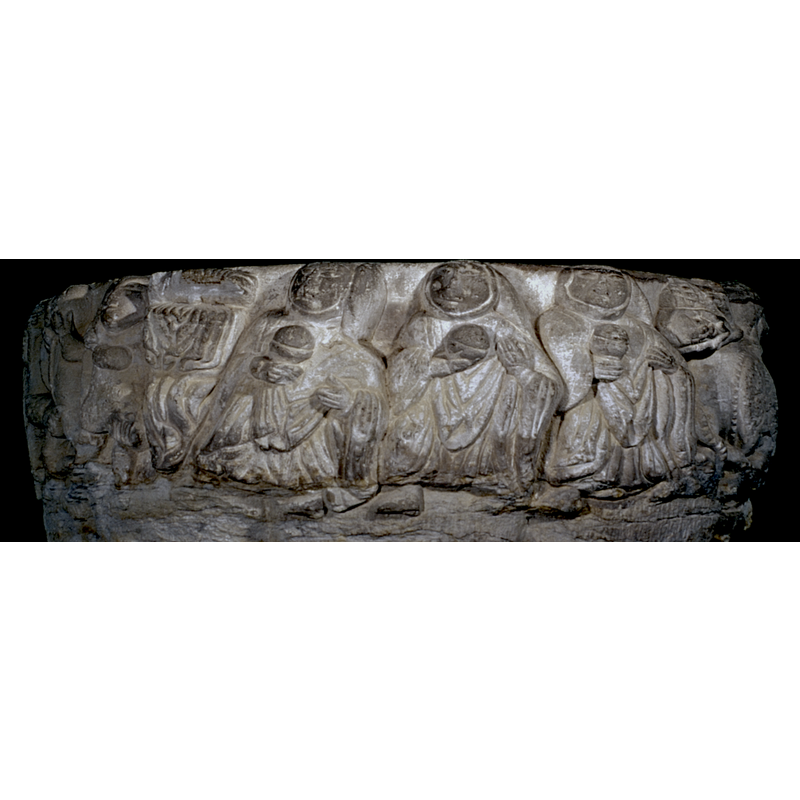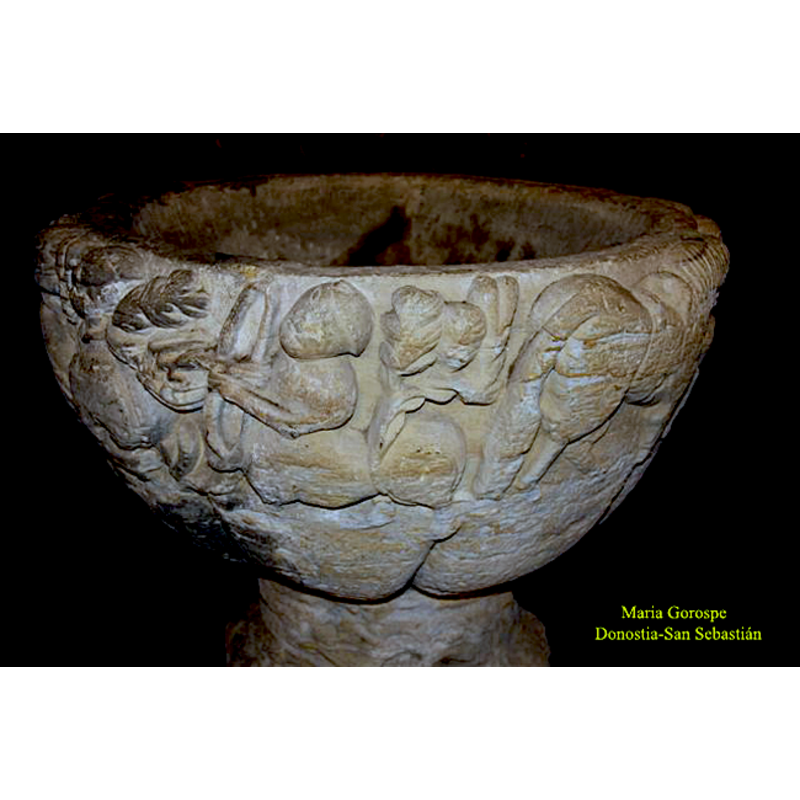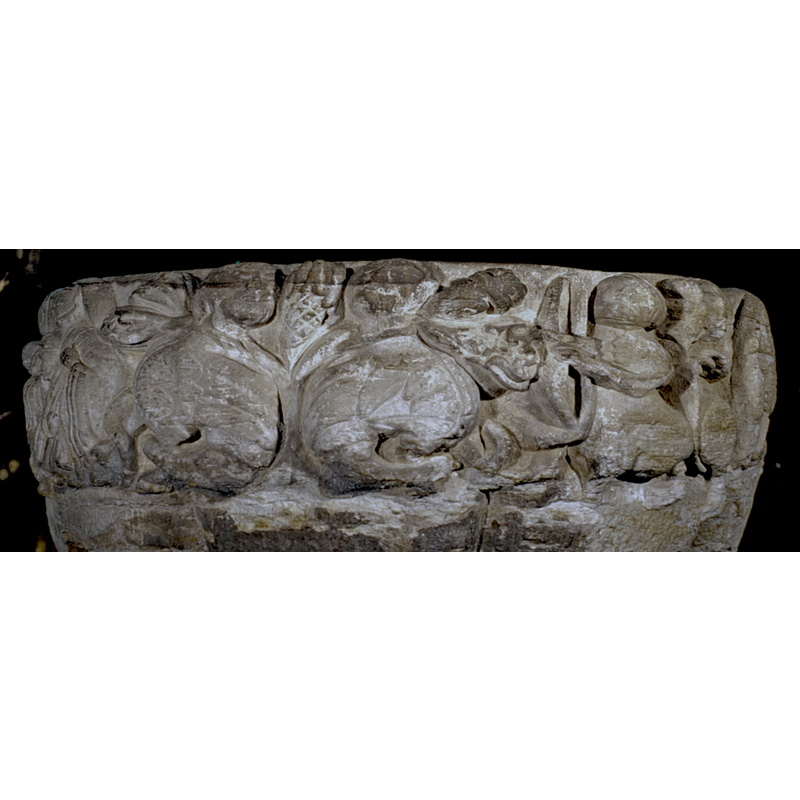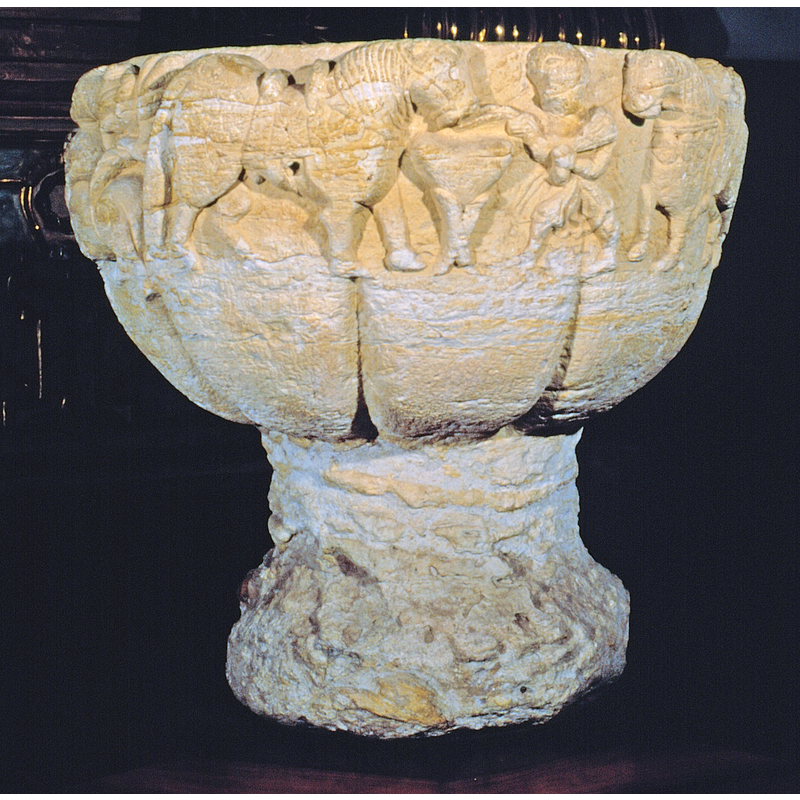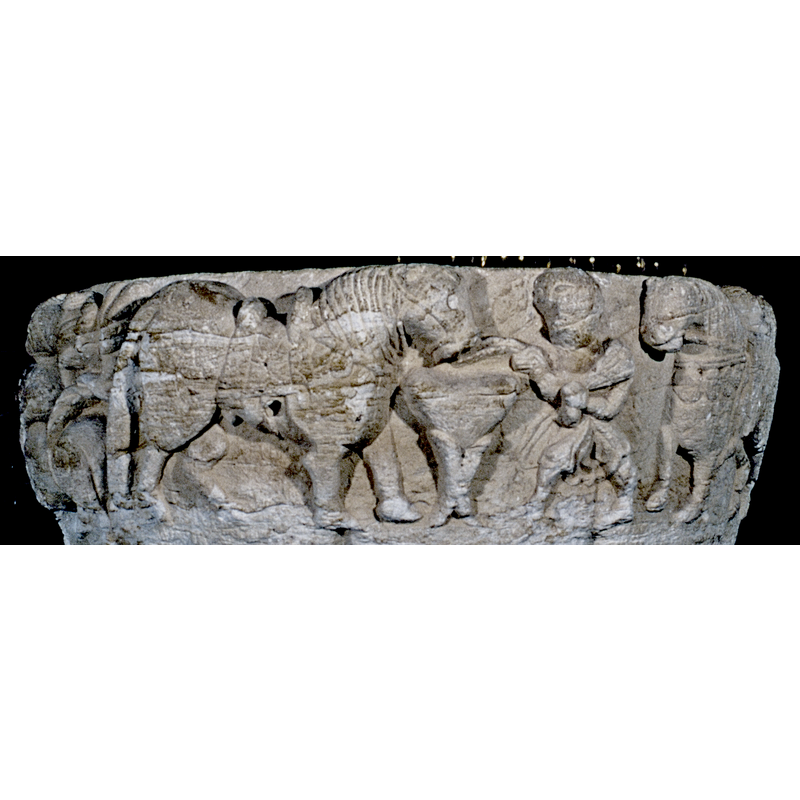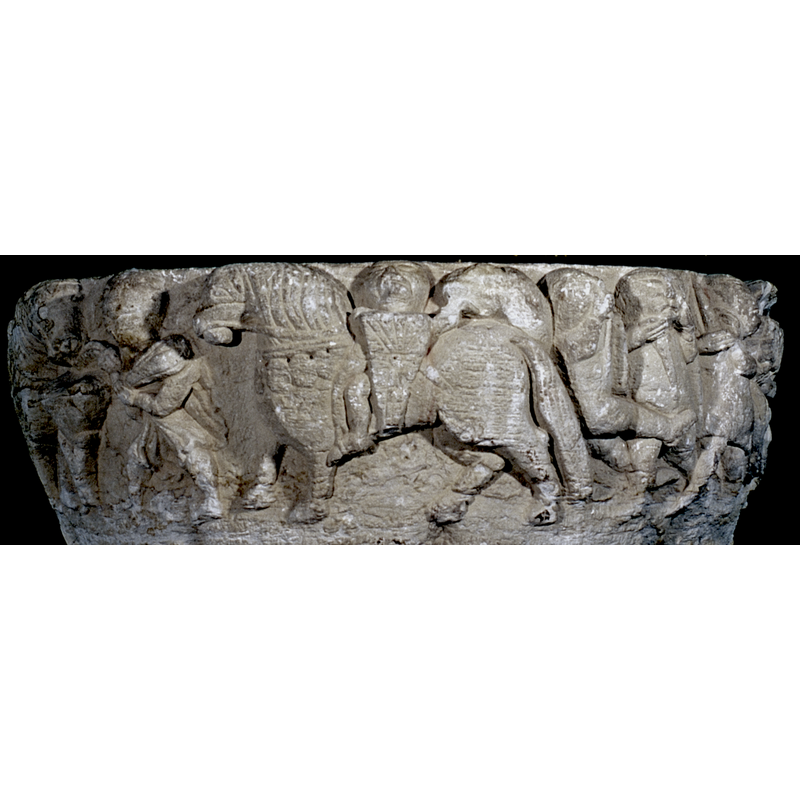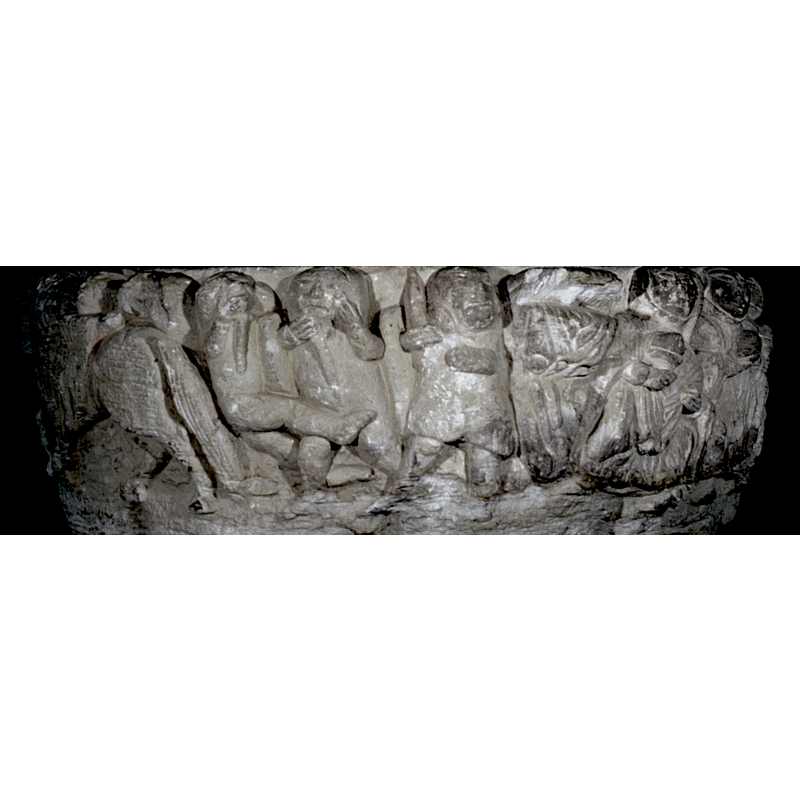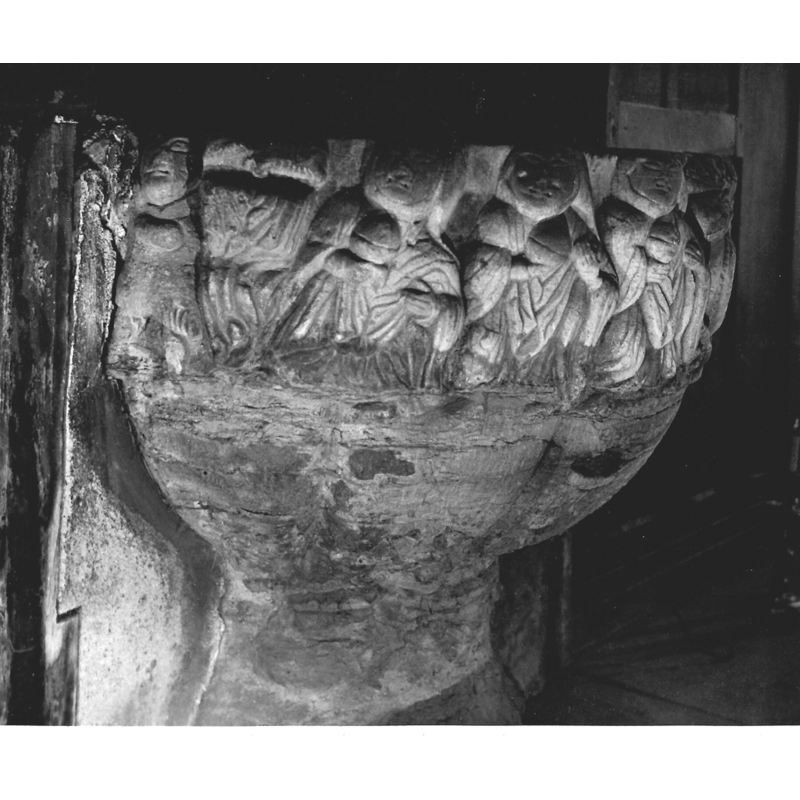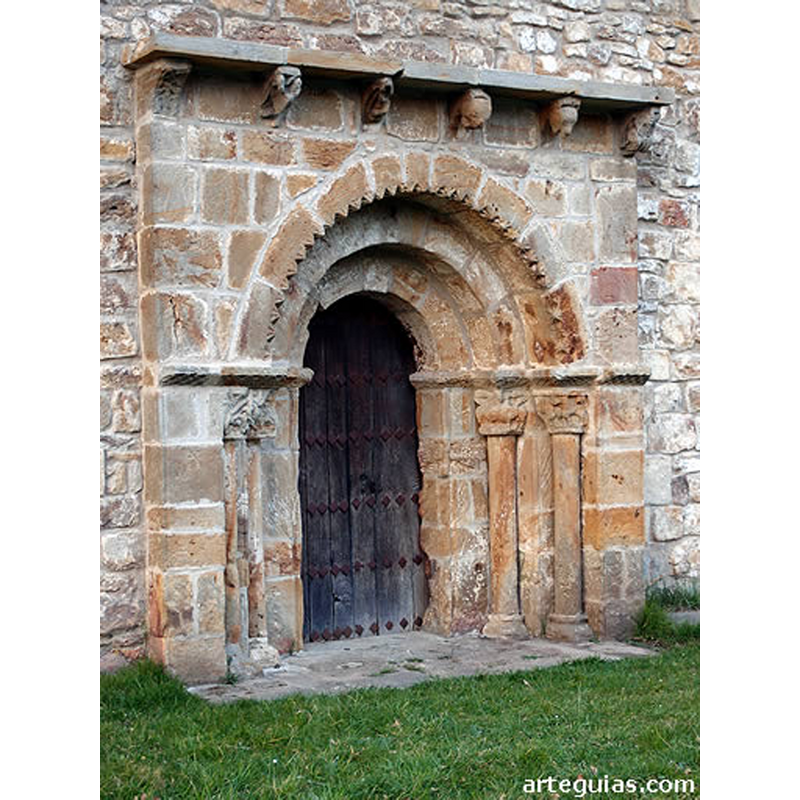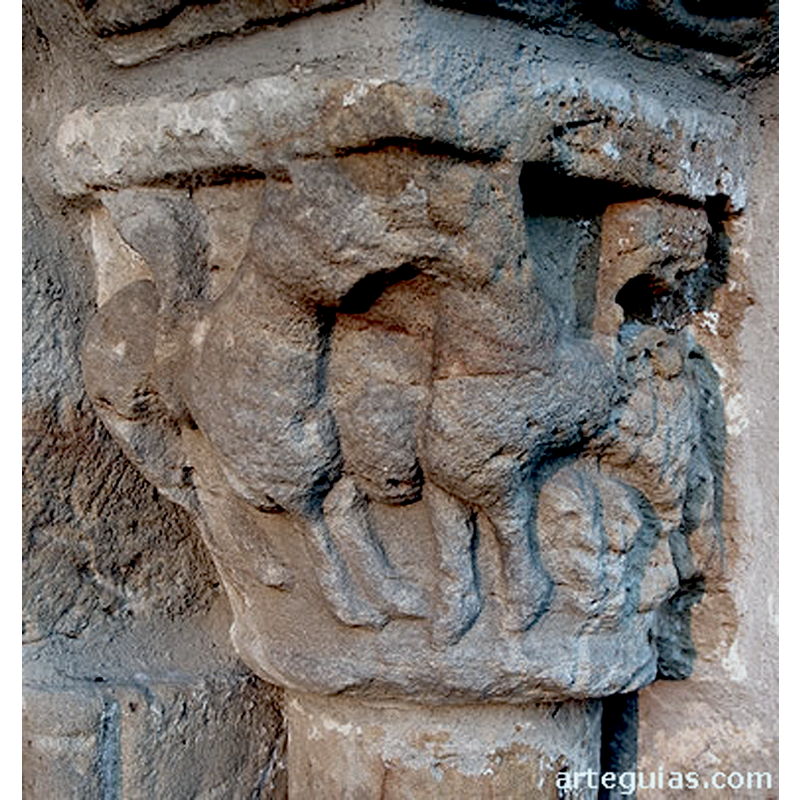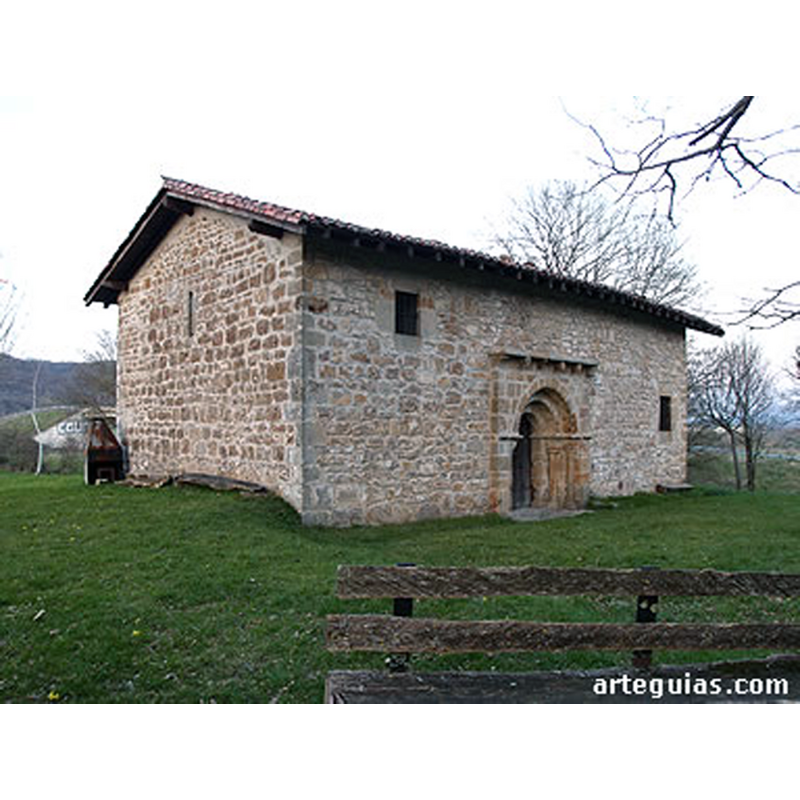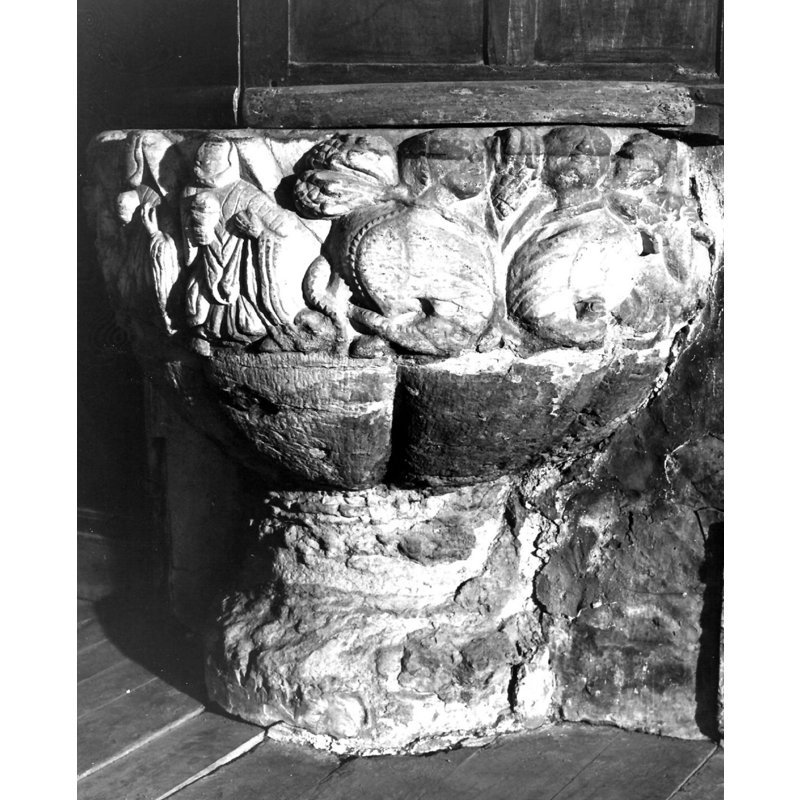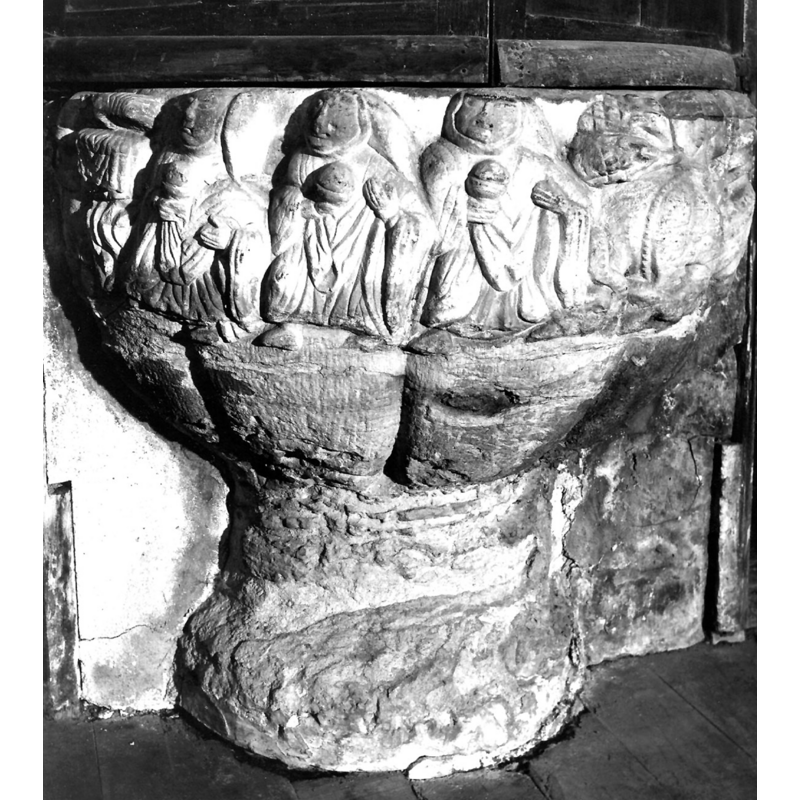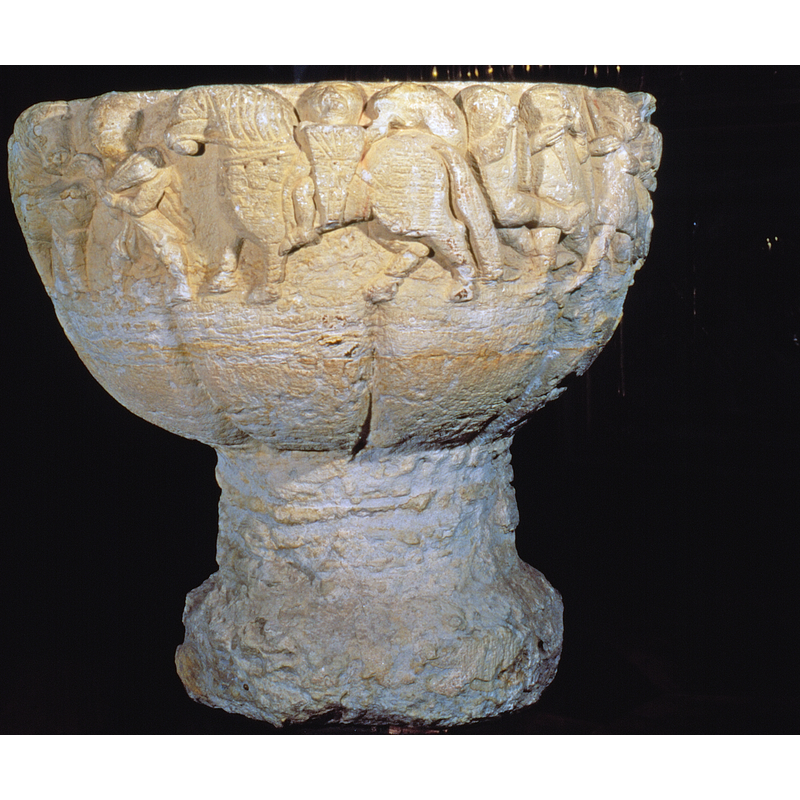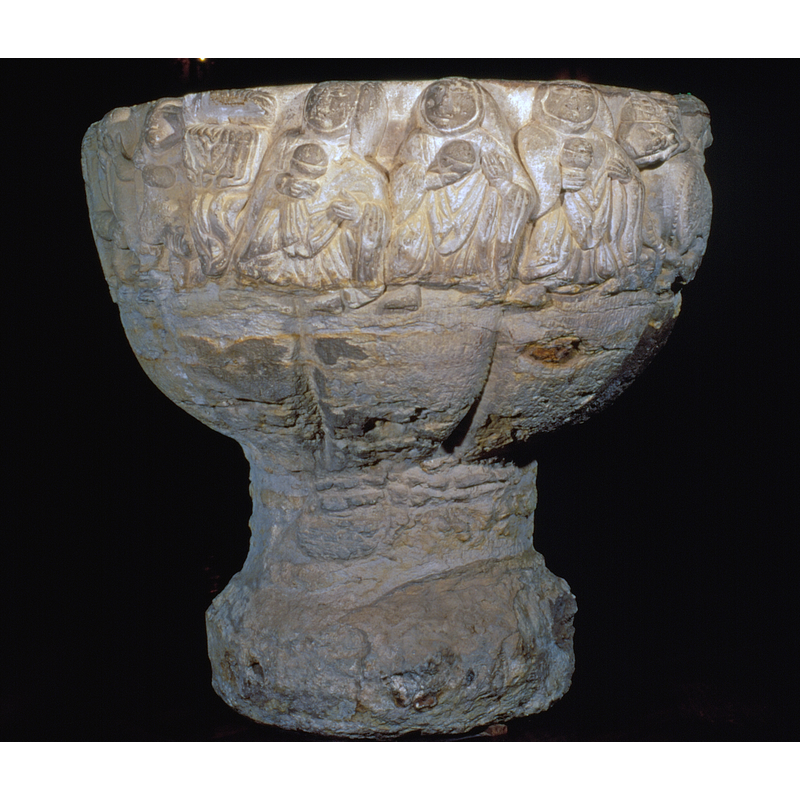Iturmendi / Iturmendía

Image copyright © Baptisteria Sacra Index, 2023
Results: 17 records
New Testament - events from Resurrection to Pentecost - the holy women (the three Maries) on their way to or at the tomb, to anoint Christ's body
animal - fabulous animal or monster - centaur - with bow and arrow
animal - fabulous animal or monster - harpy - 2
design element - patterns - ribbed - 9 ribs
human figure - male - watering his horse in a trough
human figure - warrior - on horseback - with shield
Scene Description: the view in this image is rather awkward, as the rider appears crashed behind the shield and with a scream in his mouth; the horse wears ornate decorations, especially on the front
Copyright Statement: Image copyright © Baptisteria Sacra Index, 2023
Image Source: digital image of a photograph taken 16 June 1999 by BSI
human figure - warrior - with sword - fighting - 3
Scene Description: the warrior in the centre appears to be tripping the one on the left; the one on the right appears to be addressing his attention towards Christ sepulchre and the three Marys scene on the right
Copyright Statement: Image copyright © Baptisteria Sacra Index, 2023
Image Source: digital image of a photograph taken 16 June 1999 by BSI
view of basin - detail
view of church exterior - south portal
Scene Description: the rural chapel of Aizaga at present; it was parish church of the abandoned hamlet; the font at Iturmendi was originally from this church
Copyright Statement: Image copyright © David de la Garma Ramírez / ARTEGUIAS, 2004
Image Source: digital photograph taken by David de la Garma Ramírez, of www.arteguias.com [www.arteguias.com/sierraaralar.htm] [accessed 28 November 2016]
Copyright Instructions: Standing permission
view of church exterior - south portal - detail
Scene Description: the rural chapel of Aizaga at present; it was parish church of the abandoned hamlet; the font at Iturmendi was originally from this church
Copyright Statement: Image copyright © David de la Garma Ramírez / ARTEGUIAS, 2004
Image Source: digital photograph taken by David de la Garma Ramírez, of www.arteguias.com [www.arteguias.com/sierraaralar.htm] [accessed 28 November 2016]
Copyright Instructions: Standing permission
view of church exterior - southwest view
Scene Description: the rural chapel of Aizaga at present; it was parish church of the abandoned hamlet; the font at Iturmendi was originally from this church
Copyright Statement: Image copyright © David de la Garma Ramírez / ARTEGUIAS, 2004
Image Source: digital photograph taken by David de la Garma Ramírez, of www.arteguias.com [www.arteguias.com/sierraaralar.htm] [accessed 28 November 2016]
Copyright Instructions: Standing permission
view of font
view of font
view of font
view of font
view of font
INFORMATION
FontID: 00466ITU
Object Type: Baptismal Font1
Church/Chapel: Iglesia Parroquial de San Miguel de Iturmendi
Church Patron Saints: St. Michael
Church Location: 31810 Iturmendi, Navarra, Spain -- Tel.: +34 948 56 73 22
Country Name: Spain
Location: Navarra, Comunidad Foral de Navarra
Directions to Site: Iturmendi is located off the NA-6504, 8 km E of Alsasua, 45 km from Pamplona
Ecclesiastic Region: Diocesis de Pamplona
Historical Region: La Barranca, Merindad de Pamplona
Font Location in Church: [NB: when brought to this church the font was located beneath the W gallery; it was later moved to the N side of the transept]
Century and Period: 12th - 13th century, Late Romanesque
Credit and Acknowledgements: We are grateful to the Institución Príncipe de Viana and photographers Larrión & Pimoulier, all of Pamplona, Spain, for the additional images of this font. We are also grateful to Maria Gorospe and Mikel Unanue, of Amigos del Romanico, for their photographs of this font, and to David de la Garma Ramírez, of www.arteguias.com, for his photographs of the old Ermita, and to the Fundación Santa María la Real [www.romanicodigital.com] for their permission to reproduce content from the Enciclopedia del románico
Church Notes: The Ermita de Nuestra Señora de Aizaga, where the font is said to originate, was originally the parish church of the now abandoned hamlet of Aizaga
Font Notes:
Click to view
Described and illustrated in the Catálogo Monumental de Navarra (1990?) as a baptismal font originally from a rural chapel at nearby Aizaga [NB: the original font from Iturmendi is now at the Ermita de Nuestra Señora, in Aizaga -- cf. Index entry for Aizaga for the font originally from Iturmendi San Miguel]; hemispherical basin with sides divided into two parts: the underbowl, ornamented with broad ribs, and the sides proper ornamented with narrative scenes: 1)Three Marys at the tomb; 2)two harpies; 3)centaur about to shoot an arrow; 4)mounted knight with shield; 5)horseman taking his horse to water; 6)three warriors in a sword fight. The base is cylindrical and much worn. Described and illustrated in Domeño (1992) in much the same terms and dates to the second half of the 12th century. Dated to the 12th century also in the Gran Enciclopedia Navarra (1990). Described and illustrated in the Enciclopedia del románico en Navarra (2008) as an exceptional piece, one of the few in Navarra with a historiated figural programme; suggested date in the early 13th century: "en la parroquia de San Miguel Arcángel se custodia la pila bautismal de la iglesia de Aizaga que fue trasladada allí en 1864. Fue dispuesta en el sotocoro donde permaneció empotrada en un nicho, cubierta por una capa de cal. Hace unas décadas, fue reubicada en el brazo norte del crucero, donde está situada en la actualidad. Sin embargo, su emplazamiento original fue el ángulo noroccidental de la iglesia de Aizaga, donde permaneció su pedestal cuadrangular hasta hace pocos años, cuando su pavimento de cantos rodados fue sustituido por baldosa y la plataforma fue colocada en el exterior de la ermita, junto a la portada. Esta pila bautismal constituye una pieza excepcional dentro del panorama medieval navarro, pues es uno de los escasos ejemplares que conservan decoración figurada e historiada. Su taza semiesférica (95 cm de diámetro por 47 de altura) aparece organizada en dos niveles. En el inferior se labran gallones lisos de gran profundidad con gajos muy marcados aunque planos, sin apenas curvatura. En el friso superior, sin embargo, se narran diversas escenas. En primer lugar, aparece tallado un centauro sagitario apuntando a una pareja de arpías afrontadas separadas por una piña colgante entre sus cabezas. Ambas narraciones están enmarcadas por motivos vegetales. A continuación se dispone un grupo de tres mujeres, las tres Marías dirigiéndose hacia el sepulcro donde reposaba el cuerpo de Jesús. Están vestidas con tocas con barboquejos, largas túnicas y mantos en una escena marcada por un manifiesto movimiento de avance. Llevan, además, en sus manos derechas unos recipientes con perfumes para embalsamar el cadáver.
Seguidamente se esculpe el sarcófago de piedra con la tapa ligeramente alzada, vacío, y del cual pende un extremo del sudario. Justo al lado, aparecen figurados los tres soldados que custodiaban la tumba, portando espadas en sus manos. Manifiestan gestos de terror en sus expresivas caras, que cubren con sus manos. La escena resulta cómica, pues el último de ellos prácticamente cae al suelo como consecuencia del susto. Finalmente, aparece cincelada una doble escena caballeresca. En primer lugar, un caballero con escudo adornado con rodela monta su caballo enjaezado. Justo a su lado, otro caballero de pie, conduce a su montura, sujetándolo por las riendas, a abrevar en una fuente. Esta representación incluye temas que evidentemente conforman un programa iconográfico reconocible, junto a otros habituales o menos frecuentes en conjuntos románicos. Sin duda, la presencia de las tres Marías tiene que ver con la victoria de Cristo sobre la muerte evidenciada en su Resurrección, que a veces la teología cristiana ha relacionado con la muerte del hombre viejo y el renacer del nuevo al ser liberado del pecado original mediante el bautismo. Según Domeño y de acuerdo con explicaciones propuestas para grupos semejantes, la escena del centauro y las arpías podrían aludir a la lucha contra el pecado. Mucho más problemática es la captación del significado de los caballeros, si es que lo tuvieron con relación a un programa de contenido religioso. La citada autora piensa que el caballero cabalgando con escudo representaría a Jesús resucitado mientras que el caballero que alimenta a su cabalgadura responde a Cristo conduciendo al buen cristiano a una Vida plena a través de la Eucaristía. Pero no hay ejemplos
comparables coetáneos con los que sustentar la hipótesis. La fuente apoya sobre un fuste prismático (39 cm) con su correspondiente basa circular. Ambos son lisos y se conservan en bastante mal estado. Estilísticamente, todos los restos escultóricos pertenecientes a la ermita de Aizaga (canecillo, capiteles, pila bautismal) guardan grandes similitudes entre sí, especialmente las figuras humanas. Por tanto, puede deducirse que son
obra de un mismo escultor ya que todas ellas responden a idéntica labra y detalles, tanto en sus cabezas, redondas y un tanto desproporcionadas, como en los ojos rasgados, las formas de las manos y la constitución del cuerpo. La ermita ha sido datada, al igual que la pila y el conjunto de
vestigios escultóricos, en el siglo XII por los autores del Catálogo Monumental de Navarra. La inclusión de hojarasca avanzada en la pila y otros detalles como el perfil de las basas o el progresivo alejamiento de los repertorios tardorrománicos más clásicos lleva a pensar que se hizo poco
después, ya en las primeras décadas del XIII." Alvarez Martínez (2007) remarks on the connection between themes of the Passion and Resurrection with the regenerative waters of baptism.
COORDINATES
UTM: 30T 571969 4748915
MEDIUM AND MEASUREMENTS
Material: stone, type unknown
Number of Pieces: two
Font Shape: hemispheric (mounted)
Basin Interior Shape: round
Basin Exterior Shape: round
Rim Thickness: 5-6 cm* +
Diameter (inside rim): 73 cm*
Diameter (includes rim): 83-84 cm* / 95 cm**
Basin Depth: 33 cm*
Basin Total Height: 47 - 48 cm*
Height of Base: 39 - 40 cm*
Font Height (less Plinth): 88 cm*
Notes on Measurements: *BSI on-site / +[inner rim, without consideration of the protruding figures] -- ** Enciclopedia del románico en Navarra (2008)
REFERENCES
Gran enciclopedia Navarra (11 vols.), Pamplona: Caja de Ahorros de Navarra, 1990
Alvarez Martínez, María Soledad, "La topografía simbólica de los repertorios figurativos", 2007, pp. 9-44; p. 36
Domeño Martínez de Morentín, Asunción, Pilas bautismales medievales en Navarra, Pamplona: Gobierno de Navarra, 1992
Fundación Santa María la Real, Enciclopedia del románico en Navarra, Aguilar de Campoo: Fundación Santa María la Real, Centro de Estudios del Románico, 2008
García Gainza, María Concepción, Catálogo monumental de Navarra, Pamplona: Gobierno de Navarra, Arzobispado de Navarra, Universidad de Navarra, [1990?]
Navallas Rebolé, A., Navarra, guía y mapa, 1986
